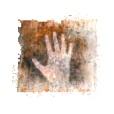Please wait a few moments while we process your request

Ælab
DATA
It is no wonder that some artists are seduced and intrigued by nanotechnologies, for it is a new frontier where one encounters the never seen before. To make the invisible visible is the mission which artists have pursued since they first left traces in the Lascaux caves. Of course, nowadays they have access to digital technologies to continue this pursuit.
DATA is the new project by the Ælab collective. It is a research, production and exhibition project that focuses on the representation of the micro and nanometric image. Let us first underline the interesting collaboration with the LennoxLab of the McGill University Chemistry department (Montreal). In fact, Dr Bruce Lennox, the director of the lab and the department chair, was immediately convinced by the pertinence of such a collaboration and consequently offered the collective a residency to undertake their research. And what he offered them was considerable: access to optical and digital microphotography technologies and the instruments used to obtain data at the nanometric scale. This access will be facilitated by Vicki Meli, a doctoral student at the LennoxLab, who will manipulate the instruments (microscopes, computers) and guide the artists in their understanding of the image on different scales.
These new possibilities for visual and formal exploration will enable the collective to confront some of the issues pertaining to representation in scientific and artistic fields. According to the artists it is about an "in depth questioning of the image's power when it becomes the unique and privileged witness of a phenomenon that is only observable on certain scales." (1) What can we expect from the power of the nano image? One can already presume transmuting images of a strange beauty. To penetrate into the confines of matter, where nothing is fixed or even solid, will certainly reveal unseen landscapes (and new ways to contemplate them). But how does one manifest this power? By inverting the scales the artists will translate the images captured from the infinitely small scale into video projections and digital prints on an immersive scale. This transfer of scales will produce destabilizing effects in relation to the daily perception of matter.
Since the artists call on a broad gamut of supports to give expression to their research Ælab's projects (2) are generally protean. For DATA, besides the prints and projections mentioned above, a minimalist soundtrack made up of laboratory recordings will accompany the images. During the residency work sessions they will pay close attention to the daily talk taking place in the lab — this talk will be incorporated in the form of quotations in the large-scale prints, slides and videos. The aim of this will be to put the images into context and provide interpretive guidelines.
DATA will be presented as a gallery installation — each exhibition space will call for a new configuration — and will form the subject of a public presentation for chemistry students. The initial results of the research leading to DATA have been presented in September and October 2003 in a group exhibition, Radical: Vaguely, curated by the late Rossitza Daskalova at the National Gallery of Sofia, in Bulgaria. The first presentation will take place from December 9 2004 to January 16 2005 at the Saidye Bronfman Centre for the Arts in Montreal. Nourished by the scientists' expertise, the artists will in turn invite them to see the fruits of their research and to talk about their perception of the exhibition, thus pursuing the rich and increasingly necessary dialogue between art, science and technology.
These new possibilities for visual and formal exploration will enable the collective to confront some of the issues pertaining to representation in scientific and artistic fields. According to the artists it is about an "in depth questioning of the image's power when it becomes the unique and privileged witness of a phenomenon that is only observable on certain scales." (1) What can we expect from the power of the nano image? One can already presume transmuting images of a strange beauty. To penetrate into the confines of matter, where nothing is fixed or even solid, will certainly reveal unseen landscapes (and new ways to contemplate them). But how does one manifest this power? By inverting the scales the artists will translate the images captured from the infinitely small scale into video projections and digital prints on an immersive scale. This transfer of scales will produce destabilizing effects in relation to the daily perception of matter.
Since the artists call on a broad gamut of supports to give expression to their research Ælab's projects (2) are generally protean. For DATA, besides the prints and projections mentioned above, a minimalist soundtrack made up of laboratory recordings will accompany the images. During the residency work sessions they will pay close attention to the daily talk taking place in the lab — this talk will be incorporated in the form of quotations in the large-scale prints, slides and videos. The aim of this will be to put the images into context and provide interpretive guidelines.
DATA will be presented as a gallery installation — each exhibition space will call for a new configuration — and will form the subject of a public presentation for chemistry students. The initial results of the research leading to DATA have been presented in September and October 2003 in a group exhibition, Radical: Vaguely, curated by the late Rossitza Daskalova at the National Gallery of Sofia, in Bulgaria. The first presentation will take place from December 9 2004 to January 16 2005 at the Saidye Bronfman Centre for the Arts in Montreal. Nourished by the scientists' expertise, the artists will in turn invite them to see the fruits of their research and to talk about their perception of the exhibition, thus pursuing the rich and increasingly necessary dialogue between art, science and technology.
Jacques Perron © 2004 FDL
















